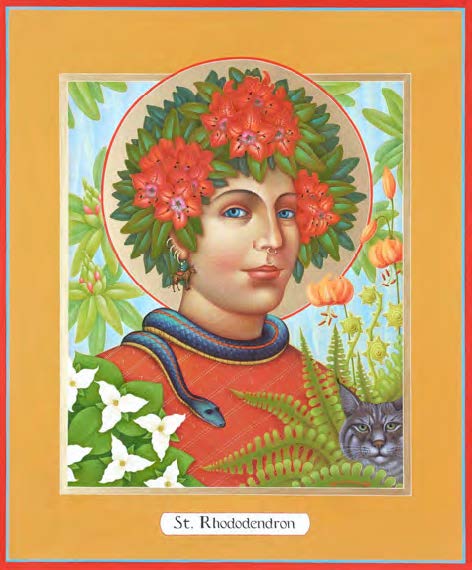Critical MAS: Timothy Wilson-Haley on Olga Volchkova’s “St. Rhododendron”

Written by Timothy Wilson-Haley
“St. Rhododendron” is an appropriation and re-imagination of Russian — and previously Byzantine — techniques for painting religious icons. Instead of traditional objects of religious idolatry, the rhododendron, a plant native to the Pacific Northwest, is the object of worship. Volchkova brilliantly employs her own visual aesthetics in ways that fit the styles of antiquity without being a simple copy. This accomplishes an imagining of what a deification of the natural world would look like when presented in a successfully appropriated structure.
Volchkova observes the ancient tropical origins of this native plant species and finds romantic mystery in its continued thriving. The brilliant rhody blossoms, complemented with trillium and tiger lily flowers, signify a timeless and perpetual spring. Joined with the flowers, and befriending the personified plant, is a snake. I am left wondering if the serpent also harkens to the ancient origins, when reptiles were the dominant animals on land, or if I am witnessing the end of the paradise as the serpent enters the garden.
The entire scene is boldly framed in vibrant colors, daring us to reject its beauty. The eyes of the personified St. Rhododendron are lifelike and also strikingly bejeweled, as icons are meant to be, as if we are being watched from above, or in this case, from earthly below. Despite the possible religious judgment, there is an openness and compassion inviting us to reimagine connection with the divine. Earth herself, that from which all life literally springs, in these times of local and global environmental catastrophe, ought to be the subject of worship: that to which we pay our penance, and say our prayers, and teach our youth to respect.
“St. Rhododendron” is an excellent replication of Byzantine Christian icons while simultaneously completely reimagining the genre. The intricate patterns within the background closely echo Byzantine methods for elaborate embellishments. However, rather than intricate geometric patterns or obvious bible stories common to the tradition, we are given abundantly more nature. The only hint of conventional religion offered is the snake, which may actually be a reference to dinosaurs and a pre-human paradise, rather than Lucifer. “St. Rhododendron” is a clever and venturesome union of iconoclasm and iconography that successfully challenges us to embrace beauty and spirituality as necessarily grounded in environmental reality.
To learn more about the writing in the Critical MAS series, go to Critical MAS: Introduction.